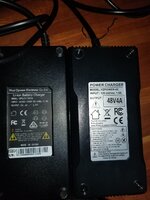Thought it interesting, was spying Bafang stuff, the charger they use for the 750 & 1000W batteries is the 2A, they offer what they call a quick charger, of 3A.
Makes me wonder if the contacts from battery to bike and within the batteries themselves are up to the task of handling 4A or even more that some are using. Some are reporting infrequent hiccups in their setups while riding.
For example, this place I have uses 20A wiring, the electrician wanted to use 15A wall sockets cause he didn't see spending extra on the 20A sockets for no reason. Well, the 15A sockets couldn't handle the additional amps and would trip the circuit breaker. Changed to 20A sockets and no problem.
Maybe the 4A charger is stressing the connections.
Makes me wonder if the contacts from battery to bike and within the batteries themselves are up to the task of handling 4A or even more that some are using. Some are reporting infrequent hiccups in their setups while riding.
For example, this place I have uses 20A wiring, the electrician wanted to use 15A wall sockets cause he didn't see spending extra on the 20A sockets for no reason. Well, the 15A sockets couldn't handle the additional amps and would trip the circuit breaker. Changed to 20A sockets and no problem.
Maybe the 4A charger is stressing the connections.

